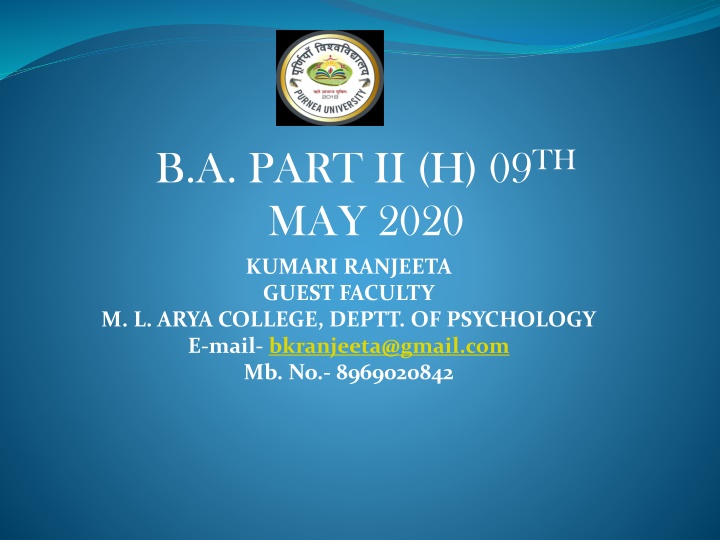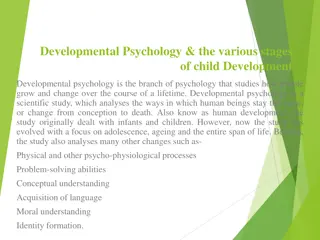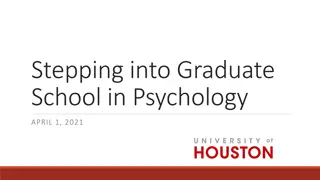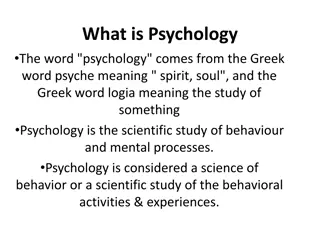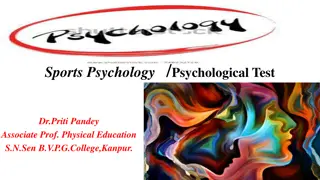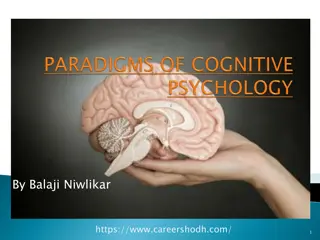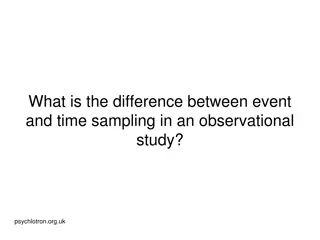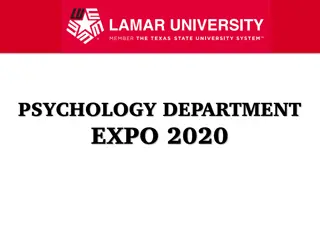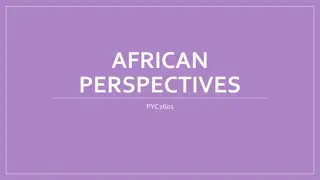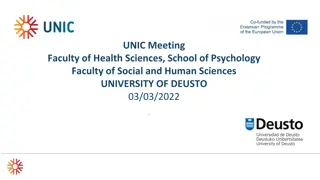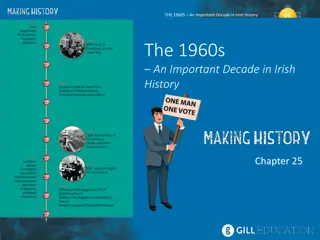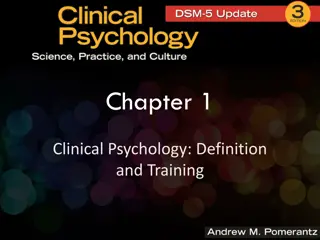Development of Community Psychology in the 1960s: A Historical Perspective
The development of Community Psychology in the 1960s was influenced by social and political movements such as the Civil Rights Movement, the Feminist Movement, and the deinstitutionalization of mental patients. This period saw the establishment of community-based mental health services and the birth of the field of Community Psychology, focusing on social justice. Training programs for Community Psychology also grew during this decade.
Download Presentation

Please find below an Image/Link to download the presentation.
The content on the website is provided AS IS for your information and personal use only. It may not be sold, licensed, or shared on other websites without obtaining consent from the author.If you encounter any issues during the download, it is possible that the publisher has removed the file from their server.
You are allowed to download the files provided on this website for personal or commercial use, subject to the condition that they are used lawfully. All files are the property of their respective owners.
The content on the website is provided AS IS for your information and personal use only. It may not be sold, licensed, or shared on other websites without obtaining consent from the author.
E N D
Presentation Transcript
B.A. PART II (H) 09TH MAY 2020 KUMARI RANJEETA GUEST FACULTY M. L. ARYA COLLEGE, DEPTT. OF PSYCHOLOGY E-mail- bkranjeeta@gmail.com Mb. No.- 8969020842
09 MAY 2020 B.A. PART II (H) PAPER III,UNIT III (COMMUNITY PSYCHOLOGY) HISTORICAL BACKGROUND OF COMMUNITY PSYCHOLOGY One needs to consider the social and political events of the 1960s in understanding the beginnings of Community Psychology. These were turbulent times, marked with protests and demonstrations involving the Civil Rights movement in the US. In 1965, the Voting Rights Act, an important accomplishment of the Civil Rights Movement, was signed into law by President Lyndon B. Johnson. The Feminist Movement was also developing momentum during the 1960s and into the 1970s, as would a similar rights movement for gays and lesbians, the environmental movement, and widespread protests against the Vietnam war. This socially-conscious atmosphere was ideal for the development of the field of Community Psychology, whose values emphasized social justice.
09 MAY 2020 B.A. PART II (H) PAPER III,UNIT III (COMMUNITY PSYCHOLOGY) During this time, there also was widespread deinstitutionalization of mental patients, as various media accounts portrayed horrendous conditions in mental hospitals. The development of antipsychotic medications such as Thorazine and the growing research evidence on the harmful effects of mental hospitalization were key factors in this movement. In 1961, the report of the Joint Commission on Mental Health and Illness was released, which recommended that we reduce the size of mental hospitals and train more professionals and paraprofessionals to meet the largely unmet need for mental health services in our society (Bloom, 1975).
09 MAY 2020 B.A. PART II (H) PAPER III,UNIT III (COMMUNITY PSYCHOLOGY) These recommendations, vigorously championed by President John F. Kennedy, led directly to the passage of the 1963 Community Mental Health Centers Act, which established community-based services widely throughout the nation. The Community Mental Health Movement was gaining momentum and many large state mental hospitals across the nation would be closed in the next 20 years. With these developments in the background, it was in 1965 that a group of clinical psychologists gathered in Swampscott, MA, and gave birth to the field of Community Psychology, which they hoped would allow them to become social change agents to address many of these pressing social justice issues of the 1960s.
09 MAY 2020 B.A. PART II (H) PAPER III,UNIT III (COMMUNITY PSYCHOLOGY) THE FIRST DECADE: 1965-1975 In the years immediately after the 1965 Swampscott Conference, a number of training programs in community mental health and Community Psychology developed in the US. For example, Ed Zolik established one of the first clinical-community doctoral programs in the US at DePaul University in 1966. A free-standing doctoral program was also established in 1966 at the University of Texas at Austin by Ira Iscoe. By 1969, there were 50 programs offering some training in Community Psychology and community mental health, and by 1975 there were 141 graduate programs offering training in these areas.
09 MAY 2020 B.A. PART II (H) PAPER III,UNIT III (COMMUNITY PSYCHOLOGY) THE SECOND DECADE: 1975-1985 The late 1970s and early 1980s could be considered the heyday of Community Psychology. During this time period, the political climate made Community Psychology both relevant and necessary, and membership in the US in APA s Division 27 (Community Psychology) rose to over 1,800 in 1983. The first Midwest Ecological Community Psychology Conference took place in 1978 at Michigan State University. This conference provided an opportunity for like-minded community psychologists and students to get together informally to discuss new developments, new training programs, and new research. This conference has now expanded beyond the Midwest to other regions of the US.
09 MAY 2020 B.A. PART II (H) PAPER III,UNIT III (COMMUNITY PSYCHOLOGY) These conferences have provided a new generation of community psychologists opportunities to put their theoretical ideas about collaboration, empowerment, and the creation of health-promoting settings into practice in their own environments. During this second decade, many community psychologists in the US became dissatisfied with the field of Community Psychology s association as one of APA s many divisions. There was a desire to bring more non-psychologists into the field. In addition, there were concerns about APA increasingly emphasizing clinical practice issues over all others. Also, there was a recognition that the term psychology no longer fit well with the work of many community psychologists.
09 MAY 2020 B.A. PART II (H) PAPER III,UNIT III (COMMUNITY PSYCHOLOGY) The group s organizational name was then changed to the Society for Community Research and Action (SCRA), and the first Biennial Conference on Community Research and Action occurred in 1987. Though many community psychologists still remain members of APA and its Division 27, SCRA now has more non-APA members than ones who belong to APA; the Biennial has become the major national professional venue for Community Psychology. In the next class we discuss about next decade of Community Psychology.
